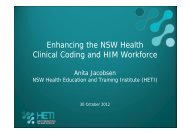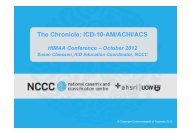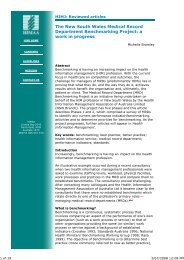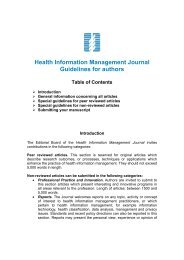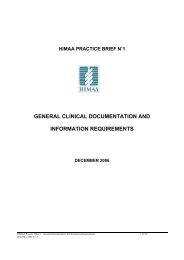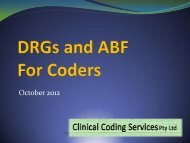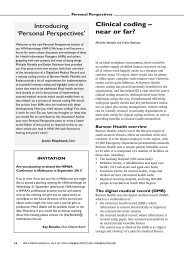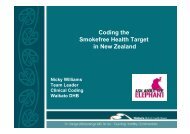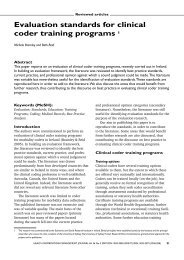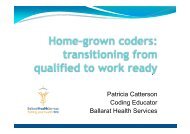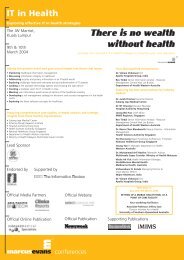A framework for evaluating health classifications - Health Information ...
A framework for evaluating health classifications - Health Information ...
A framework for evaluating health classifications - Health Information ...
You also want an ePaper? Increase the reach of your titles
YUMPU automatically turns print PDFs into web optimized ePapers that Google loves.
Reviewed Articles<br />
the in<strong>for</strong>mation system. Another is to enable comparability<br />
across different clinicians and sites.<br />
Example 3.3b<br />
In the first edition of ICD-10-AM, the procedure codes <strong>for</strong><br />
allied <strong>health</strong> interventions were included as a separate<br />
chapter and identified the clinician who per<strong>for</strong>med the procedure.<br />
For example:<br />
• 95254-00 [2095] Education/counselling, speech<br />
pathology<br />
• 95054-00 [2056] Education and in<strong>for</strong>mation, social work<br />
This was the first attempt to classify allied <strong>health</strong> interventions<br />
consistently and include them in a national procedure<br />
classification (Innes and Bramley 1997). Some guiding principles<br />
had to be overlooked because of the timeframes <strong>for</strong><br />
consultation, publication and implementation.<br />
In the second edition of ICD-10-AM, the codes were restructured<br />
on the basis of provider neutrality and integrated<br />
into the existing chapters of the classification, thus removing<br />
any duplication of interventions (Bramley and Innes<br />
1998). The timeframe between publication of the first and<br />
second editions allowed the NCCH to work constructively<br />
with the allied <strong>health</strong> professions to produce a classification<br />
that followed guiding principles and met the needs of key<br />
stakeholders.<br />
3.4 Semantic and conceptual scope of descriptors<br />
Category or subcategory descriptors should have a<br />
meaning (semantic scope) that corresponds to the<br />
idea (conceptual scope) being classified. When the<br />
meaning does not correspond to the idea, there is a<br />
concept mismatch.<br />
Example 3.4a<br />
If a category descriptor <strong>for</strong> an object producing an injury<br />
is ‘furniture’ then all subcategories should be items of furniture.<br />
‘Carpet’ should not be classified to this category,<br />
as it is not considered a piece of furniture. If carpet was<br />
classified to this category, then the conceptual scope of<br />
the category would need to be changed to something<br />
more representative, like ‘furniture and floor coverings’.<br />
When a category descriptor states ‘cough’, expectations<br />
are that all subcategories are instances of ‘cough’, such as<br />
‘chesty cough’, ‘dry cough’ or ‘chronic cough’. If ‘does not<br />
cough’ is included as a subcategory, then there is a concept<br />
mismatch. The category descriptor is essentially<br />
saying the patient has a cough, and statistically, the count<br />
reflects the numbers of patients who had a cough at a<br />
particular point in time. It is illogical, then, to include in<br />
those statistics a patient that does not have a cough.<br />
The International Classification of External Causes of Injury<br />
(ICECI Coordination and Maintenance Group 2004) is<br />
a multiaxial classification that captures data about the circumstances<br />
of an injury (external cause, mechanism of<br />
injury, place of occurrence, et cetera). Injury surveillance<br />
activities and injury prevention programs aim to reduce<br />
death and illness. To be effective, these initiatives require<br />
a significant level of detail and the importance of that detail<br />
is reflected in the ICECI (available online at<br />
).<br />
As part of a quality review process in the development<br />
phase of the ICECI, a taxonomic review was conducted to<br />
test the technical qualities of the classification. Part of<br />
this work was conducted by the NCCH. A few minor irregularities<br />
relating to semantic scope were identified and<br />
rectified in version 1.1.<br />
Descriptors <strong>for</strong> procedures or interventions<br />
should not include diagnostic in<strong>for</strong>mation, where<br />
possible (Innes et al. 1997; National Committee on<br />
Vital and <strong>Health</strong> Statistics Subcommittee on Medical<br />
Classification Systems 1993). The logic behind this<br />
principle is, again, redundancy. Diagnostic in<strong>for</strong>mation<br />
is captured in the disease codes, so there is<br />
no purpose to capturing it again in the procedure<br />
codes.<br />
Example 3.4b<br />
The Australian Classification of <strong>Health</strong> Interventions<br />
(ACHI) (National Centre <strong>for</strong> Classification in <strong>Health</strong> 2004)<br />
classifies surgical procedures and other clinical interventions.<br />
One principle in developing procedure <strong>classifications</strong><br />
is to avoid including diagnostic in<strong>for</strong>mation in the<br />
category or subcategory descriptors. The descriptor<br />
should correspond with the procedure being per<strong>for</strong>med,<br />
rather than the disease being treated, <strong>for</strong> example ‘transplantation<br />
of liver’ or ‘lobectomy of lung’. Having said<br />
that, there are instances where the diagnostic in<strong>for</strong>mation<br />
is inextricable from the procedure, <strong>for</strong> example ‘haemorrhoidectomy’,<br />
or warranted, such as ‘excision of pilonidal<br />
sinus’.<br />
3.5 Unique categories <strong>for</strong> important concepts<br />
Concepts that have particular importance within a<br />
domain should have their own unique category in a<br />
statistical classification (Hoffman & Chamie 1999).<br />
These concepts are important <strong>for</strong> public <strong>health</strong> purposes,<br />
research or statistical reporting and so should<br />
be easily distinguishable.<br />
Who determines which concepts are uniquely distinguished<br />
from others? In developing and maintaining<br />
<strong>health</strong> <strong>classifications</strong>, many ‘voices’ are taken into<br />
account, not just those of the developers. The influential<br />
voices are not purely based on clinical research<br />
and discovery. Political reasoning can dominate, as<br />
can technological, social, religious, legal, moral and<br />
ethical reasoning (Bowker & Star 1999). Balancing<br />
the needs of all stakeholders means compromise. In<br />
any process involving consensus, it is the strongest<br />
voices that have the most influence and will be heard<br />
above other voices who will generally be silenced<br />
(Bowker & Star 1999).<br />
Example 3.5<br />
Consider that in 1977, homosexuality was classified as a<br />
mental disorder in ICD-9. The guidelines clearly stated<br />
that it was to be coded to this category ‘whether or not<br />
it is considered as a mental disorder’ (World <strong>Health</strong> Organization<br />
1977: p.196). The fact that homosexuality<br />
was considered a pathology then was probably underpinned<br />
by strong political, legal, social, moral and religious<br />
voices. Opinion must have been divided though<br />
and hence the inclusion of the guidelines.<br />
By 1992, the term is absent in the ICD-10 because of:<br />
the strongest voices being now a reflection of the<br />
changing social norms; the emerging influence of gay<br />
and lesbian advocacy groups; and empirical data showing<br />
little support <strong>for</strong> its pathological classification (Herek<br />
2005?; Narrain and Chandran 2002?; Smith, Bartlett &<br />
King 2004; Stakelbeck & Frank 2003; Wu 1998).<br />
<strong>Health</strong> In<strong>for</strong>mation Management 2005 ISSN 1322-4913 Vol 34 No 3 Page 77



